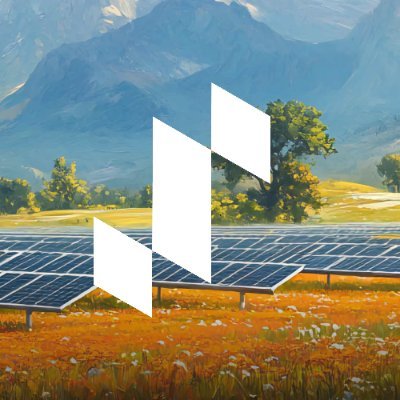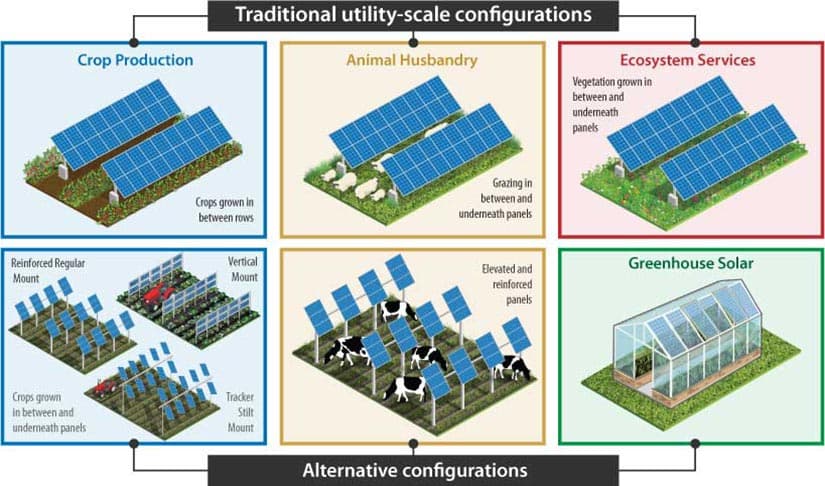Exploring Agrivoltaics: Configurations And Benefits For Solar Farms



If you are here, it means that you already know that Agrivoltaics is the practice of combining agriculture and solar energy generation on the same land, and that it offers several configurations to maximize land use and efficiency. Here are some common configurations:
Ground-Mounted Solar Panels
Setup: Panels are installed on the ground, elevated above crops.
Benefits: Provides shade for plants, which can help in hot climates, while still allowing farmers to grow underneath.
Vertical Solar Arrays
Setup: Panels are positioned vertically, often in rows.
Benefits: This design saves space and can capture sunlight without shading crops too much, making it good for small areas.
Solar Canopies
Setup: Panels are mounted high on supports, creating shaded areas below.
Benefits: Protects crops from harsh weather while allowing farming to continue underneath.
Rooftop Solar on Agricultural Buildings
Setup: Solar panels are placed on the roofs of barns, greenhouses, or other structures.
Benefits: Utilizes existing buildings for energy generation without taking up farmland.
Integrated Photovoltaic Systems (BIPV)
Setup: Solar technology is integrated into building materials, like greenhouse roofs.
Benefits: Generates energy while still serving as part of the building’s structure, keeping land free for farming.
Dynamic Tracking Systems
Setup: Solar panels that move to follow the sun’s path throughout the day.
Benefits: Increases energy production while still allowing farming practices below.
Seasonal Adjustments
Setup: Systems can be adjusted according to seasonal crop needs.
Benefits: Maximizes light for different crops at different times of the year.
Each configuration is designed to maximize land use and can vary based on the types of crops, climate, and specific farming practices. The goal is to generate solar energy while still allowing for productive agriculture.
How do I know which configuration is right for me?
Choosing the best Agrivoltaics configuration depends on several factors, including the type of crops you grow, the climate, and your farming practices. Here’s a step-by-step approach to help you decide:
1. Assess Your Land
- Size and Shape: Larger or irregularly shaped fields may allow for different configurations.
- Soil Type: Certain crops thrive in different soil types, which may influence your decision.
2. Consider Crop Types
- Shade Tolerance: Some crops benefit from shade, while others require full sun. Choose a configuration that aligns with the needs of your crops.
- Growth Height: Taller crops may need more clearance under solar panels.
3. Evaluate Climate Conditions
- Sunlight Availability: Assess the average sunlight your location receives. This will affect the efficiency of different solar configurations.
- Weather Patterns: Consider local weather conditions (e.g., strong winds, heavy rains) that may influence the durability of structures.
4. Analyze Energy Needs
- Energy Demand: Determine how much energy you need and what you want to power (e.g., irrigation systems, farm equipment).
- Grid Connection: Consider if you want to be connected to the grid or if you prefer off-grid solutions.
5. Financial Considerations
- Budget: Evaluate your budget for initial setup and ongoing maintenance. Some configurations might have higher upfront costs.
- Incentives and Grants: Research available funding, incentives, or grants for solar installations in your area.
6. Local Regulations and Policies
- Zoning Laws: Check local regulations regarding land use, height restrictions, and permits needed for solar installations.
- Agricultural Policies: Understand any agricultural policies that may affect how you can integrate solar with farming.
7. Consult Experts
- Agrivoltaic Specialists: Reach out to agrivoltaic consultants or companies with experience in your region.
- Local Extension Services: Agricultural extension services can provide insights based on regional practices and research.
8. Trial and Adaptation
- Pilot Projects: If possible, consider starting with a small pilot project to evaluate how a particular configuration works for your specific conditions.
- Feedback Loop: Monitor performance and make adjustments based on what you learn.
By taking all these factors into account, you'll be better positioned to choose the Agrivoltaics configuration that works best for you.
Our team of experts can help you decide which type of Agrivoltaics configuration is right for you. Start your Solarpunk journey!